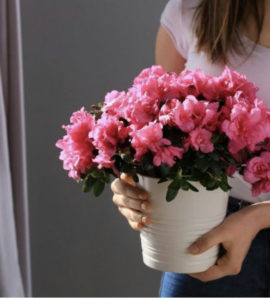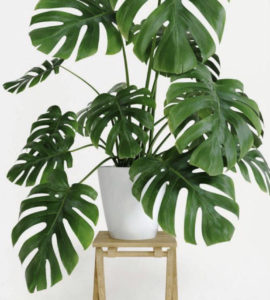Live plants are used for landscaping interiors, purifying the air in an apartment, increasing productivity in the workplace, and simply because of their aesthetics. The difference between representatives of ornamental cultures can be striking: austere cactus, an expressive orchid, and an elegant palm tree are home flowers, but combining them into one flora group seems illogical. Therefore, all plants that are usually cultivated at home are divided into several groups. Intra-group diversity allows you to choose a crop for landscaping any space.
The catalog of domestic flower crops includes the following large groups:
Representatives of the first two groups of cultures retain decorativeness throughout their lives, without changing their appearance. Seasonal beauty is characteristic of potted decorative flowering species: during the flowering period they become bright and attractive, and when the life of the inflorescences ends, the plants become inconspicuous until the next ripening of the buds.
The division of ornamental crops into relatively small groups, as in the case of palms and orchids, is due not only to significant differences in decorative characteristics, but also to large differences in care requirements.
When choosing ornamental greenery in the house, first of all, you need to pay attention not to the group to which the plant belongs, but to the conditions in which it should be kept. If the microclimate parameters in an apartment or office are very different from those familiar to a flower, it will lose its decorative characteristics, and the flowering variety will not release buds.
This group includes specimens whose main attraction is concentrated in the sheet. The flowering of these crops is inexpressive, and many decorative-leaved varieties do not bloom at all when kept in an apartment or office. The lack of beautiful flowering compensates for the year-round expressiveness of foliage: it is decorative-leaf flowers that are often found in phytodesign.
Leaves of crops in this group can have a monochromatic or spotted color of all shades of green, pink, red, purple, yellow, white. There are varieties of decorative varieties with shiny smooth leaves, matte, velvet, prickly, rough or fluffy petals. A variety of twigs sizes – from a few millimeters (for saltilium) to tens of centimeters (for monstera). Leaf shape can also vary greatly from geometrically correct to asymmetrical. Decorative-leaved flowers include varieties with feathery shoots, torn foliage, thorn-like processes, heart-shaped, scalloped and variegated branches.
The most popular types of ornamental plants are:
Since this group of flowers is very large, and the species in it differ in the requirements for care, it is impossible to draw up general recommendations for the maintenance of these plants. Evergreen varieties of flowers are considered the most unpretentious, however, among them there are exceptions in the form of rather demanding specimens, so it is better to study the conditions of their maintenance before purchasing a plant.
The main feature of representatives of this group of cultures is their ability to bloom. During the formation and growth of buds, the plant acquires a bright, eye-catching accent. The duration of flowering depends on the variety: impatiens, brunfelsias, anthuriums and Saintpaulias can bloom almost all year round, losing buds only for a short time, hibiscus, petunia and levkoy bloom up to six months, but aspidistra produces inflorescences very rarely and for a short time.
The species diversity of flowering crops allows you to revive the interior with bright buds at any time of the year:
Depending on the type of flower in the pot, its inflorescences can be either tiny or huge, emit a pungent, strong aroma, smell moderately or have no smell at all. All these features should be studied before buying a plant, especially if you only met it in the photo: a heavy smell can not only irritate and cause a headache, but also lead to the development of allergies, due to which you will have to get rid of the flower.
Most flowering crops need moderate or abundant watering, sufficient lighting (and some with additional phytolamps), feeding during the flowering period and pruning after its end.
All types of indoor flowers from this category have one characteristic feature: after flowering, the bush loses strength, and many specimens die. The classic representative of such plants is poinsettia (Christmas star). The flowering of poinsettia is so inconspicuous that you may not even notice it: tiny dull inflorescences are lost against the background of spectacular red bracts. Despite the small size of the buds, their very formation depletes the plant, and after flying around the inflorescences, the Christmas star loses its leaves and withers.
Bulbous plants can also be referred to the category of short-lived flowering: after flowering, the aerial part of such plants dies, however, with proper care, the potential for re-growth after a period of “hibernation” remains in the bulb.
Decorative flowers in this category are also called pineapple flowers. Bromeliads are crops with bright flowering and expressive leaves, used in the phytodesign of exhibitions and special events. These are quite rare types of indoor flowers: being considered not too whimsical to care for, these plants nevertheless need to maintain a stable temperature and high humidity, which is not suitable for all growers.
Even those who are far from floriculture are familiar with these beautiful exotic flowers: both potted and cut orchids are given by March 8, February 1, for a birthday or anniversary. Each variety of potted orchid is demanding in its own way: some species need abundant and frequent bathing, others require relatively rare watering, alternating with frequent sprays. The lighting regime is also dictated by the orchid variety: Wanda, Cattleya and Oncidium like bright light, Cymbidium, Miltonia and Cambria prefer moderate lighting, Phalaenopsis and Pafiopedilum are best kept in the diffused rays of the sun.
Both feathery and fan-shaped indoor palms love warmth and sunlight. Palm crops need to be watered abundantly, and transplants they endure with great stress. Such plants are bought immediately in a large pot that can accommodate the growing root system.
Home ferns need high humidity and good lighting without direct sunlight. Many crops need a nighttime temperature drop and regular watering: at temperatures above 25 ° C and a dry earthen coma, the plant suffers and may die if conditions do not change. Young specimens will have to be replanted every year so that the pot does not constrict their roots.
The most common domestic ferns are maidenhair, asplenium, davallia, platycerium, nephrolepis, pellea.
Ornamental fruiting crops are most often presented in the form of a tree. Most of these are tropical plant varieties that need warmth and constant moderate moisture in the soil. The most common representatives of this category of ornamental crops are dwarf varieties of lemon, orange, fig, pineapple and pomegranate. During the flowering period, most of these plants will need additional phytolamp lighting and frequent spraying. Flowering trees can give off a strong citrus scent.
A characteristic feature of succulents are fleshy leaves, in which plants accumulate moisture: in the wild they grow in deserts, where it rarely rains, and the ability to store water ensures their survival. In cacti, liquid accumulates in the trunk.
The leaves of many succulents are protected by a dense waxy coating, which allows plants to not be afraid of the sun. However, domestic species of cactus prefer not direct, but scattered sunlight and supplemental lighting with phytolamps in the dark. Watering succulents depends on the season: in winter they are hardly moistened, and in summer they are watered much less often than flowering crops.
Succulents are able to grow with each other in close quarters. Florariums and mini-gardens are often made from these flowers.



